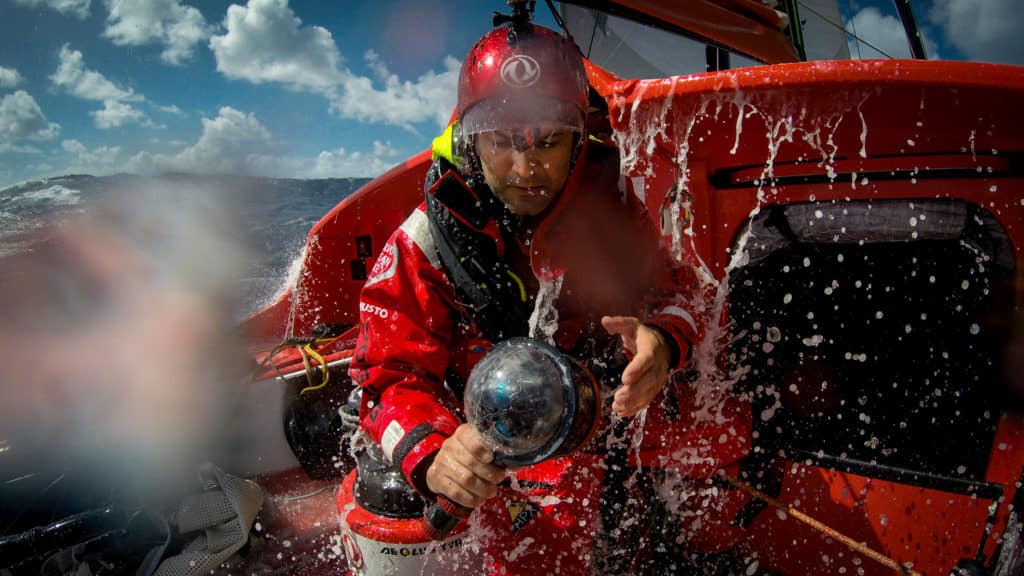
There are just hours remaining until phase one of the Volvo Ocean Race Onboard Reporter recruitment campaign closes – and thousands of hopefuls from around the globe have already responded to the Race’s call.
The storyteller search – which ended over the weekend – saw almost 10,000 candidates from 126 countries flood the campaign website to discover how to join the next batch of elite reporters willing to tackle the world’s toughest offshore challenge in the 2017-18 edition.
Leon Sefton, Head of Television and OBR recruitment project leader, is delighted with the results so far. “We’ve received a truly inspiring response from a variety of adventure film-makers, war reporters, professional journalists from leading global organisations, and fresh new talent, all in their own way demonstrating the kind of edge and desire that we’re looking for,” he said.
“Choosing who will make the final cut isn’t going to be an easy task, but it’s a great problem to have. We’re delighted to see evidence of the calibre of storytellers we’ve aimed to attract – applicants who have a clear passion for living life to the fullest, and who convey that energy and spirit through their work.
“We are working through the first batch of applications now, and the best of this group will be given priority when we run our onboard sea trials later this year.”
And for those who haven’t yet been able to send in their submission, there’s good news – from 1000 UTC on Friday 22 July, the Race will provide a second opportunity for hopeful candidates to apply. This second window will close on Friday 16 September at 1800 UTC.
“Due to the adventurous nature of this role, and the high-quality of proven storyteller we’re searching for, many potential candidates who have already contacted us have been unable to submit their application in time because they are currently engaged in a project, working offshore or on an expedition in remote corners of the globe,” continued Sefton.
“We’ve heard their feedback, and will offer a second intake window for applications starting from the end of next week.”
He added: “Everyone should have a fair chance to throw their name into the hat for this once-in-a-lifetime opportunity – and top candidates from this second batch will be offered any remaining slots in the sea trials.”
Dubbed ‘the toughest job in sports media’, it’s a unique role that certainly isn’t for the faint-hearted. Embedded in the middle of the action, the squad of multimedia journalists will move between race teams, leg by leg, to transmit the raw story from the oceans as it unfolds.
The event, which since 1973 has pitted the best professional sailors on the planet against each other over some 40,000 nautical miles, covering four oceans, five continents and nine marathon months, requires multi-skilled and experienced media professionals to join the crews onboard and report back to shore from the most remote and hostile regions on the planet.
“For a professional storyteller, I’m certain that there’s no greater challenge on earth than this,” explains American filmmaker Amory Ross, who has performed the role in the last two editions of the race.
“You are pushed far beyond your physical, mental and creative limits in a way that can compare with little else.”
To push content from the world’s oceans to race fans takes some serious technology. Every boat is fitted with state-of-the-art equipment, remote-control cameras, microphones and custom-designed media stations.
Cutting-edge communications support, provided by Inmarsat since 2005, delivers daily multimedia content to serve a global audience of tens of millions – via high-speed satellites – from each of the super-charged 65-foot racing boats while at sea.
The ideal candidates to join the elite storytelling squad, will be capable of producing high-quality video, photo and written content on a daily basis, whatever the conditions.
It cannot be underestimated how tough this role is to perform, day in, day out, in boat-breaking conditions and with little to no sleep.
The work of the Volvo Ocean Race Onboard Reporters is regularly featured across some of the world’s most recognisable media outlets, such as The Daily Telegraph, the New York Times, Red Bull Media House and 242 broadcasters on 83 television channels around the globe.
“The Onboard Reporters in the Volvo Ocean Race need to be much more than just a pretty face with a microphone. In fact, they may be performing the toughest job in sports journalism,” wrote award-winning journalist Tim Wendel in a Huffington Post story.









